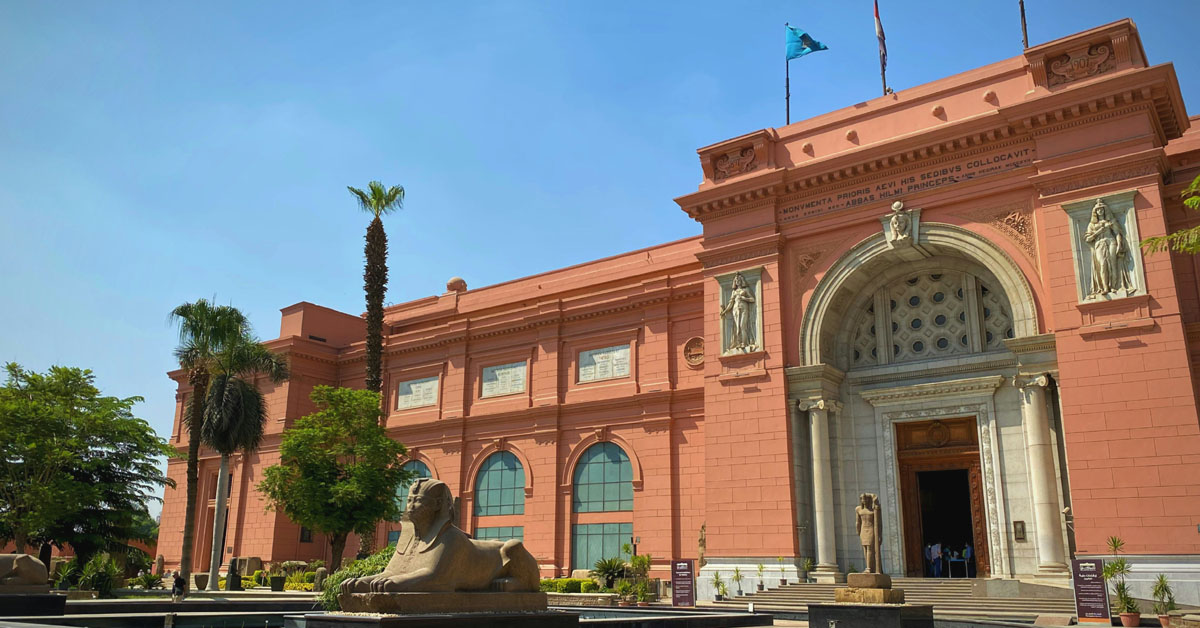15 Must-See Museums In Egypt
9 min read
Egypt has some of the world’s most incredible museums – from the grand Ancient Egyptian museums in Cairo and Luxor to the fascinating hidden gems in Alexandria and Aswan.
The Grand Egyptian Museum in Cairo (set to open in late 2024) is getting all the limelight these days.
But there are tons of museums all across Egypt that are just as much worth visiting. They’re museums that tell the stories of Ancient Egyptian animal gods, beloved Greek-Egyptian poets and famous battles of World War II.
And yes, there are even some wonderful museums in the resort towns of Hurghada and Sharm el Sheikh – if you want to add a bit of culture to your beach days.
So where do you begin? And what are the definite must-sees?
I’m a longtime expat living for more than a decade in Egypt – and I’m a huge museum nerd. I’m also the founder of a Woman’s Art Circle that visits museums every month (email me if you live in Cairo and want to join).
I’ve been lucky enough to visit Egypt’s best museums numerous times. And this is my ultimate local’s guide to the best museums in Egypt – along with hidden gems and insider tips.
1. Luxor Museum (Luxor)
The Luxor Museum has a beautiful (but manageable) collection of Ancient Egyptian treasures that will deepen your explorations of Luxor’s grand monuments.
It’s a well-labelled and spacious museum lined with statues, two royal mummies, jewelry, pottery and everyday objects from the Predynastic Period to the Islamic era. And it’s a fascinating insight into the history of Luxor itself.
Many exhibits have informative and readable labels that help you grasp the history of this ancient city. There’s also a great papyrus collection and a reconstruction of Akhenaten’s wall at Karnak.
The Luxor Museum is open until 10 pm so it’s a great to visit at night after a day spent sightseeing in the sun. It’s also air conditioned and offers a nice escape on balmy afternoons.
2. Sharm El Sheikh Museum (Sharm El Sheikh)
This new museum in Sharm El Sheikh is focused on Ancient Egypt with exhibits on themes like science, family life and animals.
There’s also a small collection of animal mummies and a beautiful coffins, cosmetics and relics of the priestess Isetemheb. Other highlights include a statue head of Queen Hatshepsut and exhibits on Sinai culture and ancient solar boats.
The Sharm El Sheikh Museum contains some 5,200 artifacts in 3 spacious halls that are well-labelled and easy to read.
Opened in late 2020, this museum is small (compared to Cairo and Luxor). But it’s full of treasures that give you a great overview of Ancient Egypt – without having to go far from the beach.
And the museum is open until 11pm – so it’s a great thing to do in Sharm El Sheikh at night.
3. Egyptian Museum (Cairo)
The Egyptian Museum in Cairo has the world’s largest collection of Ancient Egyptian antiquities – including many must-see masterpieces like the gold mask of Tutankhamun.
This iconic museum in Tahrir Square is simply massive. It holds some 120,000 items across two floors that are packed with artifacts. I’ve been going there for years and I still haven’t seen it all!
If you only see a single museum in Cairo – make it this one.
Highlights include King Tutankhamun’s gold mask, gorgeous statues, artifacts and sarcophagi from the pre-dynastic to the New Kingdom.
There are always dozens of tour guides standing outside offering their services who’ll guide you through this enormous collection.
4. Nubian Museum (Aswan)
This beautiful museum showcases the Nubian culture and history that was largely lost beneath Lake Nasser after the construction of the High Dam.
Exhibits start from 4,500 BCE and prehistoric artifacts to the treasures from the Kingdom of Kush and the time of Egypt’s “black Pharaohs.” There are also intriguing exhibits about the massive UNESCO project that relocated Nubia’s greatest monuments – including Philae and Abu Simbel – away from rising Nile waters after the building of the High Dam.
Don’t miss the beautiful statue of a 25th-dynasty priest with his distinct Upper Nubian features, and a model of a Nubian home filled with traditional furniture along with a series of mannequins wearing regional dress and silver jewelry.
There is also a large collection of photos that depict all the monuments forever lost under the waters of Lake Nasser – a poignant reminder of all the history that was left undiscovered.
5. National Museum of Egyptian Civilization (Cairo)
The new National Museum of Egyptian Civilization has 20 royal mummies and a vast collection of artifacts from Ancient Egypt through the modern day – all in a megalithic building overlooking a lake.
Highlights include the royal mummies, relics from the coffin of Sennedjem, an enormous embroidered cloth (the kiswa) that once covered the Ka’aba in Mecca.
NMEC’s collection tells the story of Egyptian civilizations from pre-historic to Ancient Egyptian, through the Greco-Roman, Coptic and Islamic periods right up until modern times.
It’s a sweeping collection that gives you a great overview of Egyptian culture through the ages.
6. Hurghada Museum (Hurghada)
The Hurghada Museum has exhibits that span Egyptian history – from ancient times and the Greco-Roman eras to the Islamic conquests and the modern day.
It’s a small museum with some 1,000 artifacts, but the exhibits are well-organized and explained. It’s a bit out of the city and it never gets very busy – so it’s a great chance to see some Ancient Egyptian treasures without the tourist crowds.
The museum’s theme is beauty through the ages. And highlights include Coptic icons and a bust statue of Queen Meritamun, the wife of Ramses II.
Like the museum in Sharm, the Hurghada Museum is also open until 11 pm (with an afternoon break) so it’s a great thing to do in Hurghada at night.
7. Royal Jewelry Museum (Alexandria)
The Royal Jewelry Museum boats an impressive collection of more than 11,000 pieces of royal jewelry, coins, clocks and portraits of Egypt’s royal family.
It’s housed inside the Fatma Al-Zahra Palace, an architectural gem known for its blend of European and Islamic styles.
The palace was completed in 1923 and served as a residence for the princess. It’s filled with paintings, gilded ceilings and ostantatious pieces like gold chessboards and jewelry commissioned by European designers.
The princess’s property was confiscated after the 1952 Egyptian Revolution. And it was turned into a public museum in 1986.
8. Gayer-Anderson Museum (Cairo)
The Gayer-Anderson Museum is packed with Ancient Egyptian antiquities, Islamic furniture and curiosities from the collection of an English officer who once called it home.
Highlights include the famous bronze Ancient Egyptian cat and rooms that let you imagine the domestic life of medieval Cairo.
It’s one of my favorite hidden gems in Cairo – and right next to the historic Ibn Tulun Mosque (which you can both easily visit in one trip).
The museum is one of the best-preserved 17th-century homes in Cairo. Its many rooms, breezy courtyard and vast collection of carpets, artwork and antiquities are a real treat for art lovers and history buffs.
9. Kom Ombo Crocodile Museum (Kom Ombo)
The intriguing Kom Ombo Crocodile Museum narrates the history of Ancient Egypt’s crocodile god – and includes an exhibit of mummified crocodiles.
Don’t miss the Kom Ombo Crocodile Museum next to the Temple of Kom Ombo with its fascinating collection of crocodile mummies, statues and curiosities.
It’s estimated that some 300 crocodile mummies were discovered in this area – and many are now on display inside the museum. They’re exhibited basking in the sand like they would in ancient times.
Other exhibits include offerings left by faithful pilgrims to the crocodile god Sobek (one of the two deities worshiped at the Temple of Kom Ombo).
10. Alexandria National Museum (Alexandria)
This brilliant museum chronicles Alexandria’s history with some 1,800 pieces from the Pharaonic and Graeco-Roman periods through recent excavations.
Head to the basement for Pharaonic era artifacts. And then see the Hellenistic gems of Alexandria’s prime when it was ruled by the Ptolemy dynasty and Alexander the Great.
The first floor has (relatively) more recent pieces from the Coptic and Islamic periods.
And don’t miss the fascinating exhibit of artifacts from the underwater excavations of the sunken city of Heracleion-Thonis, which includes a statue of Alexander the Great.
11. Cavafy Museum (Alexandria)
This small museum chronicles the life and works of Constantine Cavafy (1863-1933), a Greek-Alexandrian poet who captured the city’s Hellenistic roots.
The museum was once the poet’s residence and contains some of the original furniture along with photos, letters and manuscripts.
And it’s wildly popular with Greek tourists, who consider Cavafy one of their greatest modern poets.
Cavafy’s poetry was championed by English novelist E.M. Forster, though he didn’t gain recognition until after his death.
12. The Fossil & Climate Change Museum (Wadi al Hitan)
Wadi al Hitan, or Valley of the Whales, is an incredible open-air museum in the Egyptian desert that boasts fossil remains of one of the earliest forms of whale.
And there’s also a small indoor museum on the site with stunning fossils that narrates the region’s history of climate change.
The Fossil & Climate Change Museum contains an enormous whale fossil and smaller pieces that narrate the story of the region’s climate change.
The collection includes the largest intact whale fossil of a Basilosaurus, the largest of the ancient whales.
This indoor museum tells the story of Wadi al Hitan’s transformation across millions of years from a vibrant and diverse sea that was teeming with life to an arid desert that hardly sustains plant life.
13. Mummification Museum (Luxor)
This small museum on the Luxor corniche chronicles the Ancient Egyptian art of mummification in a series of well-presented exhibits.
It’s a small museum that never gets very crowded. But it’s a fascinating look at the eerie practice of embalming the dead – a complicated process that took the Ancient Egyptians 70 days.
On display are painted coffins, a mummy of Masaharta, a high priest of the 21st dynasty, and a series of mummified animals including cats and crocodiles. There’s even a spatula used to scrape the brain out of the corpse’s skull.
Other exhibits display canopic jars used to store the deceased’s organs, tools used during mummification, amulets to bless the body and a statue of Anubis, the jackal-headed god of embalming.
14. El Alamein Military Museum (El Alamein)
El Alamein Military Museum on the North Coast tells the story of one of the most important battles of World War II.
The museum includes an open-air exhibit lined with canons, tanks, airplanes and armored vehicles used during this decisive battle.
There are also galleries dedicated to Britain, Egypt, Germany and Italy (the four countries involved in the battle) that include weapons, maps, newspaper clipping, photos, medals and soldier uniforms.
It’s a must-see for any history or World War II buff and a great intro into the war’s North African campaigns.
15. Imhotep Museum (Saqqara, near Cairo)
This beautiful little museum in Saqqara (near the Step Pyramid) tells the story of Ancient Egyptian pyramid building.
Imhotep was the architect of the Step Pyramid, an early precursor to the perfected pyramids at Giza, and was regarded as a visionary architect who was later revered as a god.
The Imhotep Museum displays various artifacts found at the site of the Step Pyramid, including statues, coffins, alabaster jars, a recently-discovered mummy and bronze figures of ancient gods and goddesses. There are also statues of Imhotep and his building tools.
There’s also a beautiful tribute to Jean-Philippe Lauer, an Egyptologist who dedicated his life to restoring the Step Pyramid.
This museum is definitely worth a stop on your Saqqara tour and it really sheds light on the history of pyramid building.



